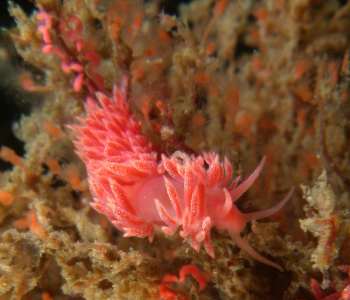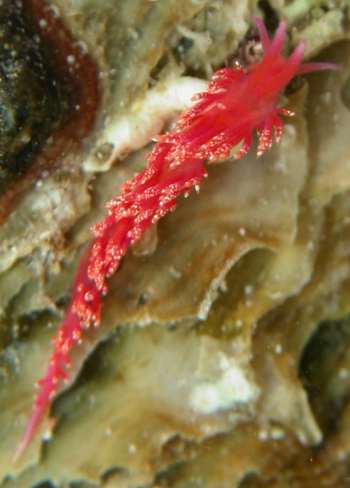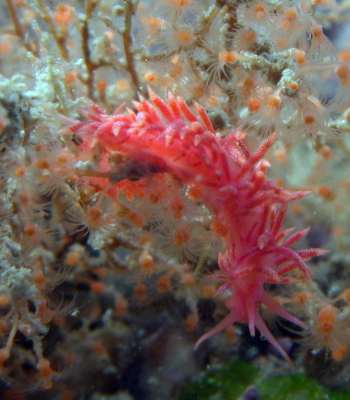

Flabellina vansyoci
Gosliner, 1994
Order: NUDIBRANCHIA
Suborder: AEOLIDINA
Family: Flabellinidae
DISTRIBUTION
Pacific coast of central America from Punta Eugenia, Baja California, Mexico to Costa Rica (Behrens, 2004).
PHOTO
Puerto Vallarta, Bahia de Banderas, Mexico. Pacific Coast. Depth: 30 feet. Length: from 7 to 15 mm. 13 May 2004. Walls. Photographer: Ali Hermosillo
The body is a translucent pink to reddish pink, the ceratal digestive gland ducts usually being a more intense reddish colour There are also opaque white specks on the ceratal wall, usually in the upper two thirds. The rhinophores, oral tentacles and posterior tip of tail can be tinged with purple, except for the tip which is a translucent white. The rhinophores are slightly verrucose (wrinkled). This species grows to about 30 mm in length.
-
Angulo-Campillo, Orso. 2002. New distributional records of opisthobranch molluscs from the Gulf of California, Mexico. The Festivus, 34(10): 117-121.
-
Bertsch, H., O.A. Campillo & J.L. Arreola. 2000. New distributional records of opisthobranchs from the Punta Eugenia region of the Baja California peninsula, a record based on 1997-1998 CONABIO-sponsored expeditions. The Festivus, 32(7): 99-104.
-
Behrens, David W. 1991. Pacific Coast Nudibranchs, A guide to the opisthobranchs Alaska to Baja California. Sea Challengers. Monterey, CA. 107pp. Second edition.
-
Behrens, David W. 2004. Pacific Coast Nudibranchs, Supplement II: New Species to the Pacific Coast and New Information on the Oldies. Proc. Calif. Academy Sciences, 55( 2): 11-54.
-
Gosliner, T.M. 1994. New records of Flabellinidae (Opisthobranchia: Aeolidacea) from the tropical Americas, with descriptions of two new species. Proceedings of the California Academy of Sciences, 48(9): 171-183.
-
Hermosillo-González. 2003. New distributional records (Mollusca: Opisthobranchia) for Bahia de Banderas, Mexico (Eastern Pacific). The Festivus, 35(3): 21-28.
Rudman, W.B., 2005 (November 17) Flabellina vansyoci Gosliner, 1994. [In] Sea Slug Forum. Australian Museum, Sydney. Available from http://www.seaslugforum.net/find/flabvans
Related messages
Re: Flabellina vansyoci from Mexico
November 22, 2005
From: Alicia Hermosillo
Dear Bill,
You are right on with the egg masses and habitat [message #15294]. Flabellina vansyoci will only feed on those hydroids and the dark pink is their egg mass. And yes, the 3-4 spots where I find F. vansyoci are the only spots where I find the hydroid, however, I have not been able to figure out what is different in those sites that make only them suitable and not others.
The egg mass of Flabellina telja is always pale pink, another difference is that F. vansyoci lays the eggs on the hydroids and F. telja does so on the substrate.
Bajaeolis bertschi, Hermosita hakunamatata, Flabellina marcusorum and Flabellina sp. from Bahia de Banderas also lay dark-rose pink egg masses, though their shapes (the egg masses) and habitats are very distinct.
Kind regards
Ali
gueri25@hotmail.com
Hermosillo, A., 2005 (Nov 22) Re: Flabellina vansyoci from Mexico. [Message in] Sea Slug Forum. Australian Museum, Sydney. Available from http://www.seaslugforum.net/find/15298Thanks Ali,
Bill Rudman
Flabellina vansyoci from Mexico
November 18, 2005
From: Alicia Hermosillo

Dear Bill,
Here are some shots of Flabellina vansyoci.
Locality: Puerto Vallarta, Bahia de Banderas, Mexico. Pacific Coast. Depth: 30 feet. Length: from 7 to 15 mm. 13 May 2004. Walls. Photographer: Ali Hermosillo
One interesting thing about this species in Bahia de Banderas is that they are very localized, found only in a few spots within the bay (which is huge, 115 km of coast line) and always in large groups.
Note the almost simple, only slightly verrucose, rhinophores. The color can vary from rose to orange. Sorry I do not have any better tub shots.
Kind regards,
Ali
gueri25@hotmail.com


Thanks Ali,
I would guess its patchy distribution is to do with the distribution of the gymnoblastic hydroids it is on in your photos, which I assume are its food? I guess the dark pink egg masses in the bottom left photo belong to Flabellina vansyoci? Do the eggs change colour or is this a useful distinction from the yellowish eggs in your photo of F. telja [message #15295]
Bill Rudman
